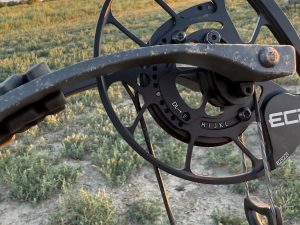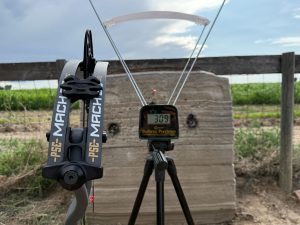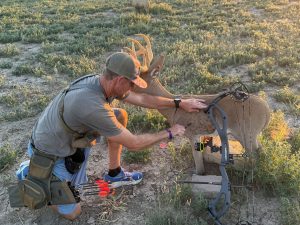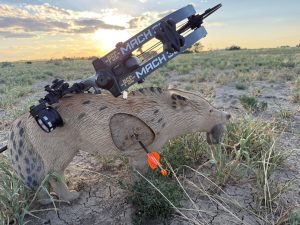During my 12-year bow-testing tenure, I’ve tinkered with many bows. I’ve reviewed every brand, and I strive to remain objective, providing consumers with factual information to help them make informed buying decisions. I aim to help you avoid buying a bow based solely on a manufacturer’s marketing campaign. Archery and bowhunting are too personal to purchase a flagship bow based on remarkable marketing. While good marketing (ads, commercials, etc.) is critical to a brand’s survival, it shouldn’t influence your final buying decision. Neither should this article. I wrote this article because the PSE Mach 33 DS is one of the best compound bows I have ever shot. There’s no question that PSE has laid some eggs over the years, but the bow builder hit a home run concerning this 33-inch axle-to-axle 6-5/8-inch brace height compound. My hope is that if you’re in the market for a new flagship bow, this article will give you some definitive insight and prompt you to shoot one of the finest compound bows I’ve ever wrapped my bow hand around. Any pro shop worth its salt will allow you to shoot the bows that they carry, and if they’re a PSE dealer, this is the one you want to test drive.
A Little PSE History
Pete Shepley is a renowned icon in the archery industry and a legendary bow designer. While working as a ballistics engineer at Magnavox, Shepley started tinkering in his free time. A serious bowhunter and competitive archer, Shepley was frustrated with the limitations of traditional recurve bows and early compound designs. Through testing and design, Shepley discovered that he could enhance a bow’s efficiency by utilizing precision machining and scientific design.
In 1970, Shepley started Precision Shooting Equipment in his home in Mahomet, Illinois. Initially, he designed and machined accessories, such as rests and sights. He also built compound bows under a license from the original patent holder (Hollis Allen).
Shepley knew he had a good thing going, but it’s hard to imagine he knew just how good. Because Shepley was making better bows than anyone else, archers and bowhunters jumped on the PSE train, which soon became a powerful locomotive.
Shepley relocated the company to Tucson, Arizona, and created one of the largest and most successful archery companies before selling Precision Shooting Equipment in February 2023.
After Heritage Outdoor Group’s investment holding company purchased the world-class bow brand, the wheels started to come off. PSE, at least initially, took some lumps. However, this compound bow maker is back in a big way.
The End Goal
Compound bow building kingpins strategize and design every year, hoping to craft a model better than its predecessor. This is getting harder to do. We are in the glory days of compound bow design. I have never shot compound bows that are so customizable and rich with purposeful technologies in my archery/bowhunting tenure.
The problem is that modern-day bows are so efficient and excellent that it’s challenging for bow makers to always trump last year’s flagship. It’s even more difficult to create a model that significantly distinguishes itself from the competition. Several times, especially over the past half-decade, I preferred a manufacturer’s previous bow model over their shiny new one.
That wasn’t the case with PSE in 2025. PSE’s Mach 33 DS is a next-level compound bow featuring a carbon riser and smooth, efficient, fast EC2 Cams, making it a joy to shoot and a top-tier in-the-field companion.
PSE Mach 33 DS First Impressions
Though the PSE Mach 33 DS comes in multiple solid and camo options, PSE must have known that I’m a sucker for Charcoal. Any shade of gray catches my attention, and this one did. The compound bow is a streamlined beauty with no nicks, dings, or scratches detected. PSE included a front and back Picatinny rail on the riser to allow for direct-to-riser accessory attachment.
The slim riser features a pair of sizable cutouts on its top and bottom, and the flat-backed, thin, and perfectly angled grip is a direct-to-riser. I love that. The EC2 Cams aren’t monstrous in size, but they have a steep back slope and are draw-length adjustable without a bow press in half-inch increments between 25.5 and 31 inches. Regarding draw length, PSE utilizes a letter system, making it easy to choose the correct draw length. I’m also glad the bow builder added a circular window to the module, centering the draw-length number to avoid any confusion.

Completely streamlined, the riser melts into the aluminum limb pockets. PSE notes that they were able to reduce weight in this area of the bow without compromising strength. At 3.9 pounds, the bow is the lightest-weight carbon compound in its class.
The split limbs have a dampener between them on the top and bottom, and the limb position is well beyond parallel, which is a common PSE limb feature. The EC2 Cams feature PSE’s EZ.220 Snap Spacer System, which enables no-bow-press needed tuning. More to come on this. The axle system is also new to the EC2 Cam. PSE engineers note that the axle system prevents the overtightening of the axle screws, thereby reducing the likelihood of damage. A carbon string stop is located below the stabilizer mounting hole. Overall, the bow looks and feels fantastic.
The PSE Mach 33 DS Build
PSE’s Mach 33 DS requires four full counterclockwise (reduce draw weight) turns before the bow can be pressed. If you don’t remember this critical step, you could damage the bow.
The Mach 33 DS presses with ease, and adding G5’s Meta Peep Pro 3/16 was non-problematic. I do wish PSE would have gone with a two-color string so you can always get half the strands of the string on one side of the peep and half on the other. The short red piece of string was low on the middle serving, and I almost pulled it through the string as I was moving it up closer to where my peep would sit.
When dealing with a solid-colored string, use a Sharpie in a color that will show up and put a mark on both sides of the string before removing the piece of serving that most bow brands set between the string. This way, if you ever drop your peep or something happens when you’re working on your bow, you can still easily divide the strands.
One of the most significant leaps forward in recent bow building is the way accessories are attached. I’m a massive proponent of direct-to-riser accessory mounting. PSE’s Mach 33 DS features two small Picatinny rails—one on the front of the riser and one on the back, allowing pic-mount systems to be attached.
Quality Archery Designs pioneered direct-to-riser mounting with the creation of the Integrate Mounting System. Though PSE utilizes a Picatinny rest rail rather than the IMS dovetail slits, QAD’s Integrate MX2 rest attaches to the rail the same way it does to the slits. Lockdown is absolute, and with no mounting bar or mounting screw, the weight is reduced. The rest also provides .0019-inch per click windage and elevation adjustments. If there is an easier-to-tune, more reliable rest on the market, I’ve yet to find it.
My sight was Spot-Hogg’s Boonie 5-Pin PM sight, and its Pic-Mount jaws with center mounting bar slid perfectly into the front Picatinny rail.
After setting my center shot, tying in the peep, attaching my D-loop, and inserting and tying in my drop-away cord into the bow’s down cable, I took the bow out of the press. Next, I turned the limb bolts back in (clockwise) and maxed them out. The measured digital scale draw weight was 70.02 pounds. Rubber-padded cable stops are incorporated into the top and bottom modules, and the removable stops have grooves for 80, 85, or 90 percent letoff adjustments. I kept mine at 80 percent. It’s important to note that the bow’s draw length would be 1/8-inch shorter in the 80 percent let-off setting than in the 90 percent setting. Cam timing was close to out-of-the-box perfect—the top stop contacted the cable less than 1/8-inch before the bottom. I tend to prefer my top cable stop to hit just before the bottom, so I left it as is.
PSE Mach 33 DS On The Range
I don’t paper tune until I get a lot of (at least 100) arrows through a new bow. Many disagree with this, but it’s a moot point. As good as modern-day strings and cables are, they will still exhibit some stretch, which can affect bow tuning. Also, I want to get familiar with the bow’s grip and how it shoots. You must get to know a bow before you paper-tune it. Take the time to ensure you can learn a grip that doesn’t induce torque and develop a two-part anchor that’s repeatable and minimizes face contact on the string.
My rule is as long as the bow is timed correctly, which I always check with a draw board, and is sending arrows with nock travel that doesn’t make my stomach churn, I keep shooting the bow on the range, getting familiar with it, reminding myself that it’s not perfectly tuned.

The Mach 33 DS, set at a draw weight of 70.2 pounds, produced a three-arrow group speed average of 309 feet per second using Easton’s 5.0 (381.5 grain) arrows. That’s fast. Better yet, the bow draws like butter. The longer brace means you don’t have too much of the bow’s 70.02-pound draw weight early in the cycle. Draw weight builds evenly, and the transition to let-off is smooth.
My favorite Mach 33 DS feature is the bow’s backwall. I’m a handheld release shooter—hinge, thumb, and tension—and though the backwall is solid, it’s also a tick spongy. Spony isn’t sloppy! A sponge is great for a handheld shooter because it allows the shooter to pull into the bow’s valley, feel that valley, and push and pull until the bow fires. The Mach 33 DS has the best backwall I’ve ever felt.
At full draw, the bow is stable. PSE refers to it as Draw Length Stability (DS). The longer brace height ensures maximum full-draw stability, and PSE engineers say that the Full Draw Stability system actively resists shooter-induced torque at full draw.
All I can write about DS is that it must be true. After crawling into my two-part anchor, the bow held on target remarkably well. Pin-float was reduced, and because I could focus on the act of aiming—the EC2 Cams not trying to pull me into the shot—I could execute excellent shots.
At the shot, the bow produces a slight thud, which is common for a carbon-riser bow, but there is zero hand vibration. This bow is dead in hand, and using a digital sound decibel measurement tool, the Mach 33 DS produced a three-shot dB average of 65.8 dB. In the compound bow world, 65.8 dB is quiet. A quiet bow that doesn’t produce post-shot hand shock and is ultra-accurate is fun to shoot and builds shooting confidence quickly.
Shooting five-spot rounds and pounding foam on 3-D targets from 20 to 100 yards, the Mach 33 DS, even with slight right nock travel, proved ultra-accurate.

Mach 33 DS Final Tune
The PSE Mach 33 DS is a breeze to tune, adding to the appeal of this sweet-shooting bow. Situated between the limbs and cams on the bow’s axle pins are EZ.220 Snap Spacers. PSE’s EZ.220 Snap Spacer System Tool snaps on the spacers, allowing the archer to swap spacers to adjust cam lean to achieve an exact tune and precise tuning. The process is a breeze and eliminated my slight nock-right paper tear. Instead of removing axle-pin clips and hammering the axle pins out to swap spacers, you make four counterclockwise limb-bolt turns, press the bow, and use the tool and the spacers.
After swapping spacers and cleaning up the tune, I shot six four-fletch Easton 5.0 arrows as well as one bare-shaft 5.0 through paper from 10 feet. The tune was perfect. Five of the six fletched arrows tore perfect holes, as did the bare shaft. One arrow required a slight nock tune, which is simply rotating the nock of the string, to achieve a perfect tear. It’s critical to tune every arrow you plan to have in your quiver.
PSE Mach 33 DS Final Range Test

The first time I shot a full 3-D course with my hyper-tuned Mach 33 DS, the wind was howling from right to left. Still, I shot a great score, only one down, and all shots were between 13 and 55 yards on various-sized targets. Four days later, on an ultra-calm morning, I shot the course again and hit a score of 10 up. I even drilled the 14-ring I went for.
The more I shoot this carbon-riser bow, the more it wows me, and the more confirmation I get that the bow will accompany me on several hunts this fall. The Mach 33 DS is an exceptional compound bow that every bowhunter needs to shoot.
Per our affiliate disclosure, we may earn revenue from the products available on this page. To learn more about how we test gear, click here.





